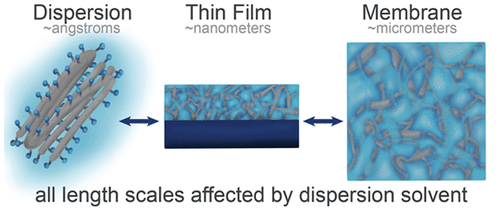当前位置:
X-MOL 学术
›
ACS Appl. Polym. Mater.
›
论文详情
Our official English website, www.x-mol.net, welcomes your
feedback! (Note: you will need to create a separate account there.)
Impact of Dispersion Solvent on Ionomer Thin Films and Membranes
ACS Applied Polymer Materials ( IF 4.4 ) Pub Date : 2020-11-23 , DOI: 10.1021/acsapm.0c01076 Sarah A. Berlinger 1, 2 , Peter J. Dudenas 1, 2 , Ashley Bird 1, 2 , Xunkai Chen 1, 2 , Guillaume Freychet 3 , Bryan D. McCloskey 2 , Ahmet Kusoglu 1 , Adam Z. Weber 1
ACS Applied Polymer Materials ( IF 4.4 ) Pub Date : 2020-11-23 , DOI: 10.1021/acsapm.0c01076 Sarah A. Berlinger 1, 2 , Peter J. Dudenas 1, 2 , Ashley Bird 1, 2 , Xunkai Chen 1, 2 , Guillaume Freychet 3 , Bryan D. McCloskey 2 , Ahmet Kusoglu 1 , Adam Z. Weber 1
Affiliation

|
Perfluorosulfonic acid (PFSA) ionomers are an important class of materials that many electrochemical devices rely on as their ion-conducting electrolyte. Often, PFSA films are prepared through solution-processing techniques. Previous research has demonstrated that the solvent environment affects PFSA dispersion conformation, but it is not clear to what extent (if at all) these conformational effects persist for thin films and membranes upon casting, nor how dispersion solvent impacts film formation during the drying process. Here, we explore these questions by systematically examining the effect of water and n-propanol mixtures on PFSA thin-film formation and structure, membrane structure, and resulting properties. Using a combination of in situ, time-resolved grazing incidence X-ray scattering and tender wide-angle X-ray scattering, it is shown that films prepared from high-water-concentration dispersions exhibit stronger interactions and arrangement upon drying, and possess larger network domain sizes than those prepared from low-water-concentration dispersions. These stronger interactions likely manifest in greater network connectivity, as evidenced by enhanced conductivity for membranes and decreased water uptake for thin films. Significantly, these solvent-induced differences persist even after thermal annealing. It is clear that the dispersion solvent choice is a critical parameter controlling PFSA nano- and mesoscale structure and presents an important dial with which to direct PFSA macroscale properties.
中文翻译:

分散溶剂对离聚物薄膜和膜的影响
全氟磺酸(PFSA)离聚物是一类重要的材料,许多电化学装置都将其用作离子传导电解质。通常,PFSA薄膜是通过溶液处理技术制备的。先前的研究表明,溶剂环境会影响PFSA分散液的构象,但尚不清楚这些构象作用在浇铸后对薄膜和薄膜的影响程度(如果有的话),或者在干燥过程中分散剂对膜形成的影响如何。在这里,我们通过系统地检查水和正丙醇混合物对PFSA薄膜的形成和结构,膜结构以及所得性能的影响,探索了这些问题。使用原位组合,时间分辨的掠入射X射线散射和柔和的广角X射线散射表明,由高水浓度分散体制备的薄膜在干燥时表现出更强的相互作用和排列,并且比制备的薄膜具有更大的网络域尺寸来自低水含量的分散体。这些更强的相互作用可能表现为更大的网络连通性,如膜的导电性增强和薄膜的吸水率降低所证明。显然,即使在热退火之后,这些由溶剂引起的差异仍然存在。显然,选择分散溶剂是控制PFSA纳米和中尺度结构的关键参数,并且是指导PFSA宏观性能的重要指标。
更新日期:2020-12-11
中文翻译:

分散溶剂对离聚物薄膜和膜的影响
全氟磺酸(PFSA)离聚物是一类重要的材料,许多电化学装置都将其用作离子传导电解质。通常,PFSA薄膜是通过溶液处理技术制备的。先前的研究表明,溶剂环境会影响PFSA分散液的构象,但尚不清楚这些构象作用在浇铸后对薄膜和薄膜的影响程度(如果有的话),或者在干燥过程中分散剂对膜形成的影响如何。在这里,我们通过系统地检查水和正丙醇混合物对PFSA薄膜的形成和结构,膜结构以及所得性能的影响,探索了这些问题。使用原位组合,时间分辨的掠入射X射线散射和柔和的广角X射线散射表明,由高水浓度分散体制备的薄膜在干燥时表现出更强的相互作用和排列,并且比制备的薄膜具有更大的网络域尺寸来自低水含量的分散体。这些更强的相互作用可能表现为更大的网络连通性,如膜的导电性增强和薄膜的吸水率降低所证明。显然,即使在热退火之后,这些由溶剂引起的差异仍然存在。显然,选择分散溶剂是控制PFSA纳米和中尺度结构的关键参数,并且是指导PFSA宏观性能的重要指标。











































 京公网安备 11010802027423号
京公网安备 11010802027423号